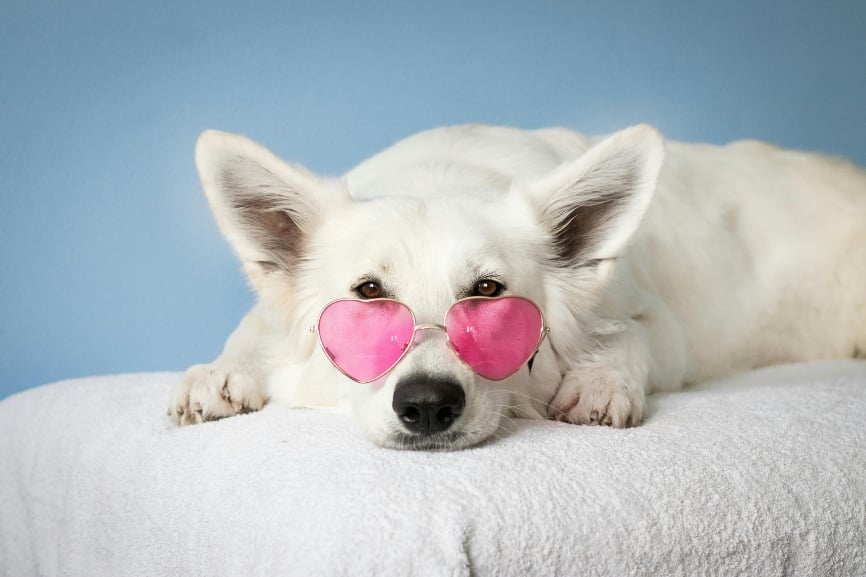You’ve just settled in for the night with your dog. The popcorn is popped, the movie is cued up, your blanket is tucked around you just right, and suddenly your dog begins tearing around the room like a swarm of bees is after him. He runs into the room, circles around the coffee table at full speed, then speeds off in the opposite direction, thundering down the hall and back again.
With rump tucked and back rounded, he’s running erratically, and for a moment your heartbeat speeds up—has he gone mad? But then you notice his open mouth, googly eyes, and the happy grin on his face, and you know he’s just caught a case of dog zoomies.
What are dog zoomies?
Also known as frenetic random activity periods, or FRAP, zoomies are an energy burst your dog just can’t contain. In what seems to be equal parts joy and pent-up energy, this dog behavior is known to affect many different dog breeds.
While most dog owners report the zoomies happening more often in young dogs, it seems to be one of those dog behaviors that crosses all boundaries of gender, age, and breed.
Zoomies are infectious fun, and if you have two or more dogs, one dog’s sudden burst of FRAP can cause the other dog(s) to join in until you have a proper stampede of crazy, wild-eyed dogs running around like they’ve lost all their senses.
It’s all fun and games until your pup takes one turn too many around the coffee table and your favorite vase falls to the floor or your popcorn catapults into the air. Thankfully, dog zoomies are usually short-lived, and with most pets, the behavior is easily curbed: a quick trip outside for some play time can make all the difference.
Dogs get the zoomies outside, too
A crisp, cool morning in fall or winter, a sunny spring day, or a long summer evening can be a perfect time to zoom around a fenced yard, or the off-leash dog park, in exuberant glee.
Sometimes a certain situation will trigger a case of the zoomies: the first snowfall of the season sends most dogs into an instant case of the zoomies, and I’ve had more than one dog get an attack of the FRAPs on beaches. There seems to be something about the soft sand that sends them into FRAP mode. And certainly, the dog park is rife with dogs getting their FRAP on.
Indoor zoomies usually don’t occur more than once per day, and often it’s at the same time of day. We know our dogs are Zen masters of routine, and sometimes an evening routine (like settling in for a TV program) or bedtime ritual will trigger the need for a quick trip (or six) around the sofa.
Dog zoomies and excess energy
FRAP behavior is especially common during winter months when the weather is bad and trips outside are all about taking care of business and getting back inside where it’s warm and dry. With a new dog or puppy, this might be the first time you really notice the zoomies—all that pent up energy comes out and off she goes.
If your dog is having daily FRAP episodes, or even multiple episodes a day, this could be a sign she’s not getting enough exercise. A long walk every day can help tire her out, and if your outdoor space is limited, find a safe place to let her off leash so she can run all that energy off.
Bathtime Zoomies
One of the most common triggers for a case of the zoomies is a bath. Most dogs, once they get out of the tub and are toweled off, will run around the house like they’ve gone mad—just like Scout here, who couldn’t stop rolling around after her most recent bath.
It’s tempting to want to let them outside to run off this exuberance, but do so at your own risk—my dogs find the nearest dirt patch to roll in, and the bath needs to be repeated.
Zoomies by age
As your dog ages, you’ll notice FRAP less and less. Where indoor puppy zoomies are a daily occurrence, older dogs generally save it for an outside zip around the back yard. My eight and nine-year-old dogs still have the zoomies—usually in the morning when we’re outside in the yard, before I leave for work.
My old guy, now almost 14, doesn’t have FRAP attacks like he did as a youngster when he would run the length of the house and back again. But even though he’s slowed down with age, he always gets a case of the zoomies after a bath.
The truth about dog zoomies
We’ve covered the reasons dogs get the zoomies, how they’re defined, and how you can help your dog get that energy out.
But the bottom line is pretty simple. Most dog people love to watch these sudden bursts of energy unfold before them. In fact, there’s almost nothing better.
It’s hard not to laugh when your dog is tearing around the yard like a maniac—the energy is infectious. It’s pure, unadulterated canine fun and one of the many reasons dogs are so good for the soul.
This post is brought to you in partnership with Rover. Founded in 2011 with headquarters based in Seattle, WA, Rover is the nation’s largest network of 5-star pet sitters and dog walkers.






